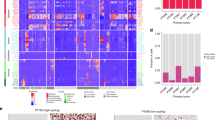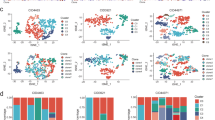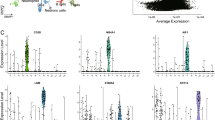Abstract
Background
Immunotherapy, represented by immune checkpoint inhibitors, has made significant progress in the treatment of cancer. Numerous studies have demonstrated that antitumor therapies targeting cell death exhibit synergistic effects with immunotherapy. Disulfidptosis is a recently discovered form of cell death, and its potential influence on immunotherapy, similar to other regulated cell death processes, requires further investigation. The prognostic value of disulfidptosis in breast cancer and its role in the immune microenvironment has not been investigated.
Methods
High dimensional weighted gene coexpression network analysis (hdWGCNA) and Weighted co-expression network analysis (WGCNA) methods were employed to integrate breast cancer single-cell sequencing data and bulk RNA data. These analyses aimed to identify genes associated with disulfidptosis in breast cancer. Risk assessment signature was constructed using Univariate Cox and least absolute shrinkage and selection operator (LASSO) analyses.
Results
In this study, we constructed a risk signature by disulfidptosis-related genes to predict overall survival and immunotherapy response in BRCA patients. The risk signature demonstrated robust prognostic power and accurately predicted survival compared to traditional clinicopathological features. It also effectively predicted the response to immunotherapy in patients with breast cancer. Through cell communication analysis in additional single-cell sequencing data, we identified TNFRSF14 as a key regulatory gene. Combining TNFRSF14 targeting and immune checkpoint inhibition to induce disulfidptosis in tumor cells could potentially suppress tumor proliferation and enhance survival in patients with BRCA.









Similar content being viewed by others
Data availability
The original contributions presented in the study are included in the article/Supplementary Material. Further inquiries can be directed to the corresponding authors.
References
Adams S, Gatti-Mays ME, Kalinsky K, Korde LA, Sharon E, Amiri-Kordestani L et al (2019) Current landscape of immunotherapy in breast cancer: a review. JAMA Oncol 5(8):1205–1214
Cao D, Xu H, Xu X, Guo T, Ge W (2019) High tumor mutation burden predicts better efficacy of immunotherapy: a pooled analysis of 103078 cancer patients. OncoImmunology 8(9):e1629258
CD36-mediated ferroptosis dampens intratumoral CD8+ T cell effector function and impairs their antitumor ability - PubMed [Internet]. [cited 2023 May 28]. Available from: https://pubmed.ncbi.nlm.nih.gov/33691090/
Cella D, Motzer RJ, Suarez C, Blum SI, Ejzykowicz F, Hamilton M et al (2022) Patient-reported outcomes with first-line nivolumab plus cabozantinib versus sunitinib in patients with advanced renal cell carcinoma treated in CheckMate 9ER: an open-label, randomised, phase 3 trial. Lancet Oncol 23(2):292–303
De novo induction of intratumoral lymphoid structures and vessel normalization enhances immunotherapy in resistant tumors | Nature Immunology [Internet]. [cited 2023 May 28]. Available from: https://www.nature.com/articles/ni.3836
Doki Y, Ajani JA, Kato K, Xu J, Wyrwicz L, Motoyama S et al (2022) Nivolumab combination therapy in advanced esophageal squamous-cell carcinoma. N Engl J Med 386(5):449–462
Drijvers JM, Gillis JE, Muijlwijk T, Nguyen TH, Gaudiano EF, Harris IS et al (2021) Pharmacologic screening identifies metabolic vulnerabilities of CD8+ T cells. Cancer Immunol Res 9(2):184–199
Du Y, Liu Z, You L, Hou P, Ren X, Jiao T et al (2017) Pancreatic cancer progression relies upon mutant p53-induced oncogenic signaling mediated by NOP14. Cancer Res 77(10):2661–2673
Feng X, Luo Q, Zhang H, Wang H, Chen W, Meng G et al (2017) The role of NLRP3 inflammasome in 5-fluorouracil resistance of oral squamous cell carcinoma. J Exp Clin Cancer Res CR 36(1):81
Frontiers | Integrating single-cell RNA-seq and bulk RNA-seq to construct prognostic signatures to explore the role of glutamine metabolism in breast cancer [Internet]. [cited 2023 May 27]. Available from: https://www.frontiersin.org/articles/https://doi.org/10.3389/fendo.2023.1135297/full
Fu W, Sun H, Zhao Y, Chen M, Yang X, Liu Y et al (2019) BCAP31 drives TNBC development by modulating ligand-independent EGFR trafficking and spontaneous EGFR phosphorylation. Theranostics 9(22):6468–6484
Fuchs Y, Steller H (2015) Live to die another way: modes of programmed cell death and the signals emanating from dying cells. Nat Rev Mol Cell Biol 16(6):329–344
Galluzzi L, Vitale I, Aaronson SA, Abrams JM, Adam D, Agostinis P et al (2018) Molecular mechanisms of cell death: recommendations of the Nomenclature Committee on Cell Death 2018. Cell Death Differ 25(3):486–541
Gao W, Wang X, Zhou Y, Wang X, Yu Y (2022) Autophagy, ferroptosis, pyroptosis, and necroptosis in tumor immunotherapy. Signal Transduct Target Ther 7(1):196
García-Hernández M de la L, Uribe-Uribe NO, Espinosa-González R, Kast WM, Khader SA, Rangel-Moreno J. A unique cellular and molecular microenvironment is present in tertiary lymphoid organs of patients with spontaneous prostate cancer regression. Front Immunol [Internet]. 2017 [cited 2023 May 28];8. Available from: https://www.frontiersin.org/articles/https://doi.org/10.3389/fimmu.2017.00563
Hänzelmann S, Castelo R, Guinney J (2013) GSVA: gene set variation analysis for microarray and RNA-seq data. BMC Bioinformatics 14:7
Harari A, Graciotti M, Bassani-Sternberg M, Kandalaft LE (2020) Antitumour dendritic cell vaccination in a priming and boosting approach. Nat Rev Drug Discov 19(9):635–652
He B, Jabouille A, Steri V, Johansson-Percival A, Michael IP, Kotamraju VR et al (2018) Vascular targeting of LIGHT normalizes blood vessels in primary brain cancer and induces intratumoural high endothelial venules. J Pathol 245(2):209–221
Hernandez R, Põder J, LaPorte KM, Malek TR (2022) Engineering IL-2 for immunotherapy of autoimmunity and cancer. Nat Rev Immunol 22(10):614–628
Hua X, Long ZQ, Zhang YL, Wen W, Guo L, Xia W, et al. Prognostic value of preoperative systemic immune-inflammation index in breast cancer: a propensity score-matching study. Front Oncol [Internet]. 2020 [cited 2023 May 27];10. Available from: https://www.frontiersin.org/articles/https://doi.org/10.3389/fonc.2020.00580
Hugo W, Zaretsky JM, Sun L, Song C, Moreno BH, Hu-Lieskovan S et al (2016) Genomic and transcriptomic features of response to anti-PD-1 therapy in metastatic melanoma. Cell 165(1):35–44
Jiang X, Stockwell BR, Conrad M (2021) Ferroptosis: mechanisms, biology and role in disease. Nat Rev Mol Cell Biol 22(4):266–282
Johansson-Percival A, Li ZJ, Lakhiani DD, He B, Wang X, Hamzah J et al (2015) Intratumoral LIGHT restores pericyte contractile properties and vessel integrity. Cell Rep 13(12):2687–2698
Kapralov AA, Yang Q, Dar HH, Tyurina YY, Anthonymuthu TS, Kim R et al (2020) Redox lipid reprogramming commands susceptibility of macrophages and microglia to ferroptotic death. Nat Chem Biol 16(3):278–290
Keenan TE, Tolaney SM (2020) Role of immunotherapy in triple-negative breast cancer. J Natl Compr Cancer Netw JNCCN 18(4):479–489
Korman AJ, Garrett-Thomson SC, Lonberg N (2022) The foundations of immune checkpoint blockade and the ipilimumab approval decennial. Nat Rev Drug Discov 21(7):509–528
Lang X, Green MD, Wang W, Yu J, Choi JE, Jiang L et al (2019) Radiotherapy and immunotherapy promote tumoral lipid oxidation and ferroptosis via synergistic repression of SLC7A11. Cancer Discov 9(12):1673–1685
Li J, Fang R, Wu J, Si Y, Bai J, Wang Q (2022) The NOP14 nucleolar protein suppresses the function and stemness of melanoma stem-like cells through Wnt/beta-catenin signaling inactivation. Bioengineered 13(3):7648–7658
Liberzon A, Birger C, Thorvaldsdóttir H, Ghandi M, Mesirov JP, Tamayo P (2015) The Molecular Signatures Database (MSigDB) hallmark gene set collection. Cell Syst 1(6):417–425
LIGHT sensitizes IFNγ–mediated apoptosis of HT-29 human carcinoma cells through both death receptor and mitochondria pathways | Cell Research [Internet]. [cited 2023 May 28]. Available from: https://www.nature.com/articles/7290210
Liu X, Nie L, Zhang Y, Yan Y, Wang C, Colic M et al (2023) Actin cytoskeleton vulnerability to disulfide stress mediates disulfidptosis. Nat Cell Biol 25(3):404–414
Morabito S, Reese F, Rahimzadeh N, Miyoshi E, Swarup V. High dimensional co-expression networks enable discovery of transcriptomic drivers in complex biological systems [Internet]. bioRxiv; 2022 [cited 2023 May 27]. p. 2022.09.22.509094. Available from: https://www.biorxiv.org/content/https://doi.org/10.1101/2022.09.22.509094v1
Nguyen LT, Ohashi PS (2015) Clinical blockade of PD1 and LAG3–potential mechanisms of action. Nat Rev Immunol 15(1):45–56
Pal B, Chen Y, Vaillant F, Capaldo BD, Joyce R, Song X et al (2021) A single-cell RNA expression atlas of normal, preneoplastic and tumorigenic states in the human breast. EMBO J 40(11):e107333
Peng F, Liao M, Qin R, Zhu S, Peng C, Fu L et al (2022) Regulated cell death (RCD) in cancer: key pathways and targeted therapies. Signal Transduct Target Ther 7(1):286
Quistgaard EM (2021) BAP31: Physiological functions and roles in disease. Biochimie 186:105–129
Rothlin CV, Hille TD, Ghosh S (2021) Determining the effector response to cell death. Nat Rev Immunol 21(5):292–304
Signatures of T cell dysfunction and exclusion predict cancer immunotherapy response | Nature Medicine [Internet]. [cited 2023 May 28]. Available from: https://www.nature.com/articles/s41591-018-0136-1
Sun C, Mezzadra R, Schumacher TN (2018) Regulation and function of the PD-L1 checkpoint. Immunity 48(3):434–452
Sung H, Ferlay J, Siegel RL, Laversanne M, Soerjomataram I, Jemal A et al (2021) Global Cancer Statistics 2020: GLOBOCAN estimates of incidence and mortality Worldwide for 36 Cancers in 185 Countries. CA Cancer J Clin 71(3):209–249
Tan G, Lin C, Huang C, Chen B, Chen J, Shi Y et al (2022) Radiosensitivity of colorectal cancer and radiation-induced gut damages are regulated by gasdermin E. Cancer Lett 529:1–10
Tang R, Xu J, Zhang B, Liu J, Liang C, Hua J et al (2020) Ferroptosis, necroptosis, and pyroptosis in anticancer immunity. J Hematol OncolJ Hematol Oncol 13(1):110
Topalian SL, Taube JM, Anders RA, Pardoll DM (2016) Mechanism-driven biomarkers to guide immune checkpoint blockade in cancer therapy. Nat Rev Cancer 16(5):275–287
Tuit S, Salvagno C, Kapellos TS, Hau CS, Seep L, Oestreich M et al (2019) Transcriptional signature derived from murine tumor-associated macrophages correlates with poor outcome in breast cancer patients. Cell Rep 29(5):1221-1235.e5
Ugolini A, Tyurin VA, Tyurina YY, Tcyganov EN, Donthireddy L, Kagan VE et al (2020) Polymorphonuclear myeloid-derived suppressor cells limit antigen cross-presentation by dendritic cells in cancer. JCI Insight. 5(15):e138581
Van Allen EM, Miao D, Schilling B, Shukla SA, Blank C, Zimmer L et al (2015) Genomic correlates of response to CTLA-4 blockade in metastatic melanoma. Science 350(6257):207–211
Wagner DL, Fritsche E, Pulsipher MA, Ahmed N, Hamieh M, Hegde M et al (2021) Immunogenicity of CAR T cells in cancer therapy. Nat Rev Clin Oncol 18(6):379–393
Wang Q, Wang Y, Ding J, Wang C, Zhou X, Gao W et al (2020) A bioorthogonal system reveals antitumour immune function of pyroptosis. Nature 579(7799):421–426
Wei SC, Duffy CR, Allison JP (2018) Fundamental mechanisms of immune checkpoint blockade therapy. Cancer Discov 8(9):1069–1086
Winer EP, Lipatov O, Im SA, Goncalves A, Muñoz-Couselo E, Lee KS et al (2021) Pembrolizumab versus investigator-choice chemotherapy for metastatic triple-negative breast cancer (KEYNOTE-119): a randomised, open-label, phase 3 trial. Lancet Oncol 22(4):499–511
Wu SZ, Al-Eryani G, Roden DL, Junankar S, Harvey K, Andersson A et al (2021) A single-cell and spatially resolved atlas of human breast cancers. Nat Genet 53(9):1334–1347
Xi G, Gao J, Wan B, Zhan P, Xu W, Lv T et al (2019) GSDMD is required for effector CD8+ T cell responses to lung cancer cells. Int Immunopharmacol 74:105713
Xia H, Wang W, Crespo J, Kryczek I, Li W, Wei S et al (2017) Suppression of FIP200 and autophagy by tumor-derived lactate promotes naïve T cell apoptosis and affects tumor immunity. Sci Immunol. https://doi.org/10.1126/sciimmunol.aan4631
Xu C, Sun S, Johnson T, Qi R, Zhang S, Zhang J et al (2021) The glutathione peroxidase Gpx4 prevents lipid peroxidation and ferroptosis to sustain Treg cell activation and suppression of antitumor immunity. Cell Rep 35(11):109235
Yu G, Wang LG, Han Y, He QY (2012) clusterProfiler: an R package for comparing biological themes among gene clusters. Omics J Integr Biol 16(5):284–287
Zhang M, Guo R, Zhai Y, Yang D (2003) LIGHT sensitizes IFNγ-mediated apoptosis of MDA-MB-231 breast cancer cells leading to down-regulation of anti-apoptosis Bcl-2 family members. Cancer Lett 195(2):201–210
Zhang Y, Chen H, Mo H, Hu X, Gao R, Zhao Y et al (2021) Single-cell analyses reveal key immune cell subsets associated with response to PD-L1 blockade in triple-negative breast cancer. Cancer Cell 39(12):1578-1593.e8
Zhu X, Jia W, Yan Y, Huang Y, Wang B. NOP14 regulates the growth, migration, and invasion of colorectal cancer cells by modulating the NRIP1/GSK-3β/β-catenin signaling pathway. Eur J Histochem [Internet]. 2021 Jul 2 [cited 2023 May 21];65(3). Available from: https://www.ejh.it/index.php/ejh/article/view/3246
Funding
This study was supported by the Foundation of Liaoning Province Education Administration (No. LJKZ0849).
Author information
Authors and Affiliations
Contributions
YX: original manuscript preparation, methods, and data curation. CX and JX: manuscript review and editing. YZ, RQ, RX, ZH and WW: software analysis. And study supervision: XF. All authors have read and approved the final version submitted.
Corresponding author
Ethics declarations
Conflict of interest
The authors declare that the research was conducted in the absence of any commercial or financial relationships that could be construed as a potential conflict of interest.
Additional information
Publisher's Note
Springer Nature remains neutral with regard to jurisdictional claims in published maps and institutional affiliations.
Supplementary Information
Below is the link to the electronic supplementary material.
Rights and permissions
Springer Nature or its licensor (e.g. a society or other partner) holds exclusive rights to this article under a publishing agreement with the author(s) or other rightsholder(s); author self-archiving of the accepted manuscript version of this article is solely governed by the terms of such publishing agreement and applicable law.
About this article
Cite this article
Chen, Y., Jin, C., Cui, J. et al. Single-cell sequencing and bulk RNA data reveal the tumor microenvironment infiltration characteristics of disulfidptosis related genes in breast cancer. J Cancer Res Clin Oncol 149, 12145–12164 (2023). https://doi.org/10.1007/s00432-023-05109-y
Received:
Accepted:
Published:
Issue Date:
DOI: https://doi.org/10.1007/s00432-023-05109-y




